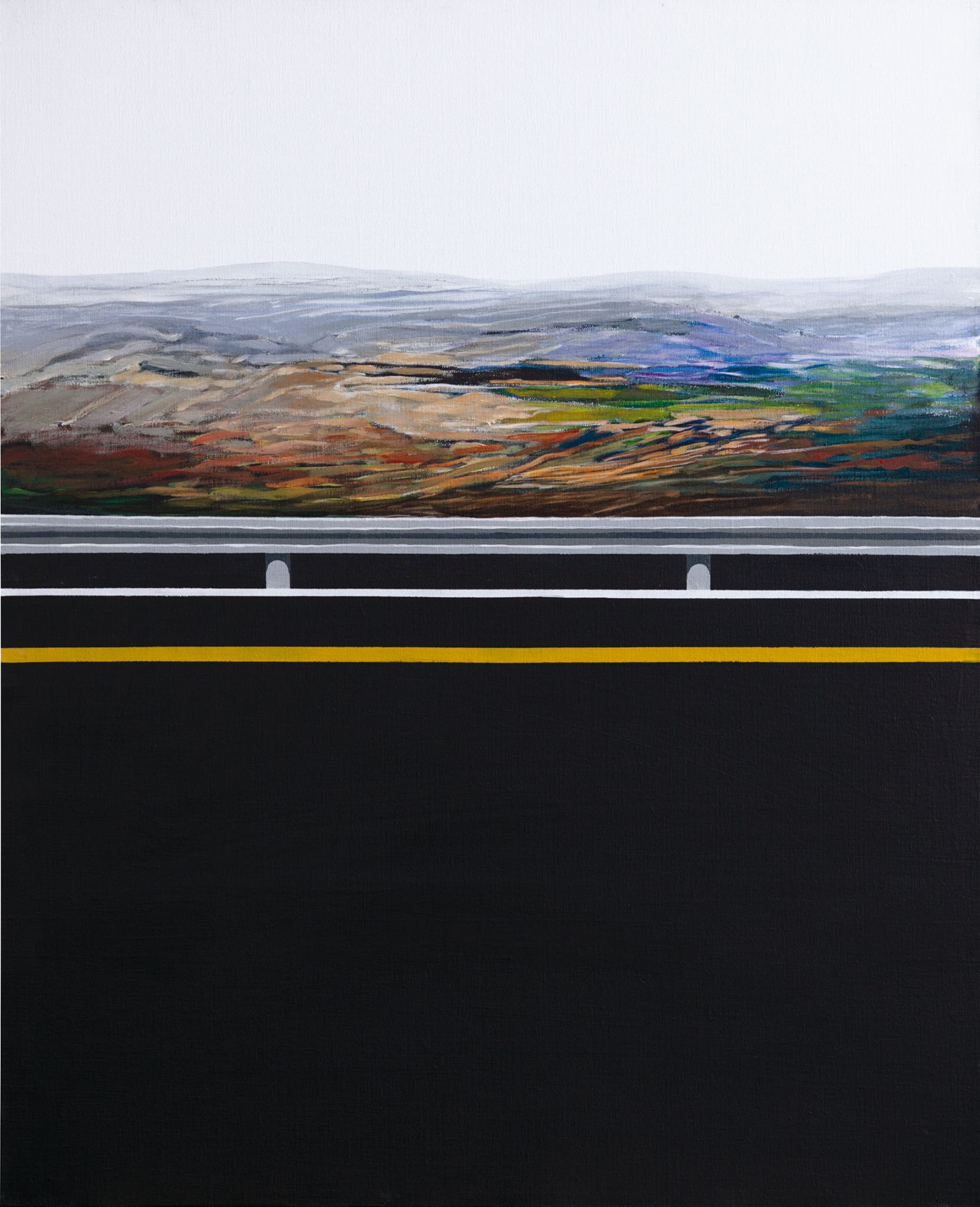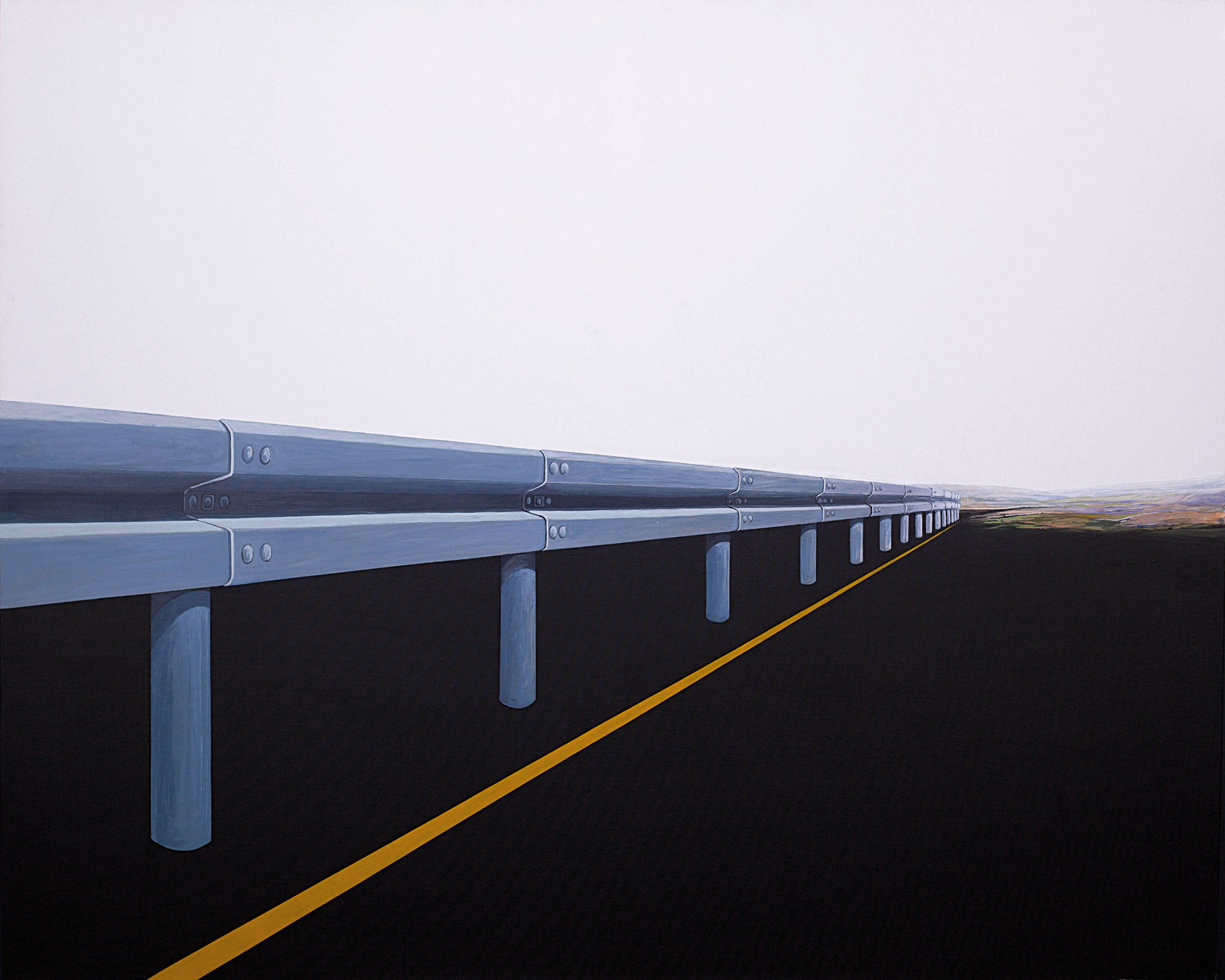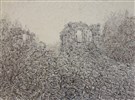The tension between home and homeland is an ever-present subject that informs the work of many contemporary Palestinian artists. Since the beginning of the uprooting and fragmentation of the Palestinian people by an extended and expanding settler-colonial occupation nearly seventy years ago, the Palestinian experience of home has become largely diasporic and transportable, while their vision of a homeland, appears and disappears like a promising mirage that seductively lays just beyond reach.
Rafat Asad’s new paintings investigate the chasm between home and homeland with somber images that reflect on the current state of a forced odyssey that continues to be imposed on the Palestinians. Although his artwork is by no means the first to consider the existential crisis caused by catastrophic displacement, Asad’s current paintings are at the forefront of an evolving pictorial tradition that investigates themes of loss, resistance, delusions, and responsibilities, in the epic journey of Palestinians. His images of roads, road barriers, and inaccessible vistas raise numerous timely questions regarding the endgame that may be looming just over the “next turn in the road.” By eliminating the use of figures, recognizable spaces, and overt political symbols Asad’s parsimonious compositions compel the viewer to soberly reflect on a critical juncture in the Palestinians’ historical journey on the “Trail of Tears.[1]”
Unlike many of his creative predecessors and contemporaries, Rafat Asad’s new paintings, examine the Palestinians’ troubled crossing between home and homeland from a perspective that deliberately avoids conventional tropes of repression and resistance. His compositions are completely devoid of representations of heroic struggle in the face of tragic suffering and are intentionally absent of personal narratives, intimate histories, national nostalgia, or theatrical gestures. Although several of the paintings are purposely commanding in scale, they are deceptively designed to initially look pedestrian in their compositional structures, and predominantly appear to prioritize formal objectives. At first glance, the viewer can easily mistake Rafat Asad’s paintings as formalist compositions that employ the geometry and the subdued color palette evident in the structures of guard rails, the curves of roads, and the physically imposing silhouettes of billboards and power transformers. In Asad’s paintings, the ubiquitous utilitarian structures that clutter highways are strongly contrasted against the shifting lushness and organic sensuality of landscapes that lay in the background of his compositions, just beyond the immobile barriers.
 [Rafat Asad, Bypass (2015). Image copyright the artist. Courtesy of Gallery One, Palestine.]
[Rafat Asad, Bypass (2015). Image copyright the artist. Courtesy of Gallery One, Palestine.]
First glance observations of Asad’s paintings are intentionally misleading and have been orchestrated to disarm the viewer’s preconceptions and expectations. The formalism of the paintings allows viewers to gaze at the images without immediately pondering the narrative interplay of familiar similes, imbedded symbols, and intended messages. While the meaning of the paintings is calculated to reveal itself gradually, the pictorial weight of the black fields expedites the viewers’ emotional recognition of the content by imposing a mournful tone on the images. The black fields dominate the shallow foreground of each of the compositions and govern the viewers’ visual, emotional, and intellectual engagement with the paintings.
Asad’s visual compositions act on the viewer viscerally and are accessed emotionally before they can be analyzed intellectually. It is at the intellectual stage of perception that the viewer begins to reflect on the tension that separates home from homeland, and to perceive the cyclical interplay between the metaphorical representation of national desire and political denial. The compositions that Rafat Asad arranges in his paintings deliberately tease the viewer with the possibilities of open space, distant travel, and the ability to envision a field of dreams that transcends predestined limitations. But the strategically placed barriers in the paintings deny the viewer access to the promised possibilities that deceptively appear just within reach. The barriers compositionally trap the viewers in the unambiguously lifeless black fields that define the shallow foregrounds. The overbearing black foregrounds dominate all of Asad’s compositions and serve as recurring mournful stanzas, demarcating the cyclical progression towards a repeatedly obstructed future.
Asad’s paintings prompt a litany of questions: Where did these roads originate? Where do they lead? Who built them? Where does one stand in this journey? Are the barriers designed to protect or to restrict? Why is access to the landscapes repeatedly denied? Has the land become an open-air-prison? Are the blatantly imposed barriers that restrict and control movement perceived as normally occurring structures by inhabitants/inmates who have grown habituated to their presence? If the nomadic concept of home is where the refugees happen to temporarily settle on their forced “Trail of Tears” then are Rafat Asad’s narrow and sterile black fields a metaphor for the tiny slivers of land that remain of the so-called Homeland/Bantustans/Reservations that the Palestinians have been driven into? Does Asad deliberately place the viewer in the shallow black foreground space so that we become psychological participants in the physical and emotional abyss presented in the paintings? Are the imposing barriers and guardrails metaphors of denial that prohibit access to the desired homeland? Are the blurry and distant landscapes metaphors of an increasingly vanishing homeland? Has the dream of Palestine become as unattainable as the land has become inaccessible?
Rafat Asad’s new paintings are his most ambitious, subtle, and sophisticated works to date. Their conceptual complexity and pictorial intelligence are directly informed by the fact that the images are created by a forty-four-year-old Palestinian artist whose entire life has been defined by the seemingly routine, yet utterly abnormal, daily encounters with the violent restrictions and repressive manipulations of a militarily enforced settler-colonial occupation.
Asad’s new paintings offer a mournful assessment of the actual outcomes of the numerous so-called peace strategies that have been foisted on the Palestinians. The images remind us that the various internationally imposed road-maps-to-peace have deliberately driven the Palestinians deeper into the black hole of occupation while deceptively promising them the normalcy of a homeland. Rafat Asad’s paintings of roads-to-nowhere, offer no opportunities to exit or to turn around. They provide no signage, no road markers, and no accessible information. The slivers of roads depicted in Asad’s paintings present little more than a freshly re-paved “Trail of Tears.”
 [Rafat Asad, Bypass #15 (2015). Image copyright the artist. Courtesy of Gallery One, Palestine.]
[Rafat Asad, Bypass #15 (2015). Image copyright the artist. Courtesy of Gallery One, Palestine.]
In each of the paintings, the road and the landscape presented are fundamentally disconnected from each other through the use of colors, surface treatment, clarity, and focus. There is also a deliberate confusion in the perception of motion in the paintings. This momentary misperception is calculated to further distinguish the static nature of the journey. At first look, Asad’s compositional arrangement of the guardrails and other immobile structures seem to suggest that the viewer is moving forward on the highway. But a closer look reveals that the sharp-focused depictions of the guardrails, fences, and silhouetted billboards identify the viewer as standing still on this highway. Adding to this misperception is the fact that the blurry landscapes appear to suggest forward motion. The indistinct landscapes look like cinematic projections of moving fields that are being screened behind a stationary prop, in order to imply a sense of forward movement from the vantage point of the viewer. But in fact the opposite is depicted in Asad’s paintings. It is the landscapes that are moving away while the vantage point of the viewer is completely stationary. The fixed vantage points conveyed by the thin slivers of foreground spaces communicate an absolute stillness of movement, advancing the metaphor of being increasingly trapped in a devastating political black hole. The black fields represented in Asad’s paintings are airless, sterile, and vacuum-like in the disturbing pictorial power they exert.
In Asad’s illusory journeys to a homeland, what at first appear like ordinary representations of roads, guardrails, and barriers, serve fundamentally as metaphors of constant and seemingly accustomed restrictions. Asad’s paintings are presented as ordinary scenes that comment on the unordinary existence of indigenous inhabitants who continue to be herded into disconnected “reservations.”
Corralled onto a highway to nowhere, the displaced and trapped travelers possess nothing but their dreams and imagination to transport them beyond the rigidly imposed barriers, and carry them from nomadic homes to a desired homeland.
*Eltifaf-Bypasswas on view at Gallery One from 4 April until 19 March, 2016.
[1] “The Trail of Tears” is a term first used by the Cherokee Nation to describe the genocidal removal from their native lands, of all indigenous tribes living east of the Mississippi River, in the southern United States.
To facilitate the flood of white settlers who coveted the fertile lands of the Indigenous People, the forced removal of Native Tribes was repeatedly and brutally implemented throughout the Americas. President Andrew Jackson’s signing of “The Indian Removal Act” into law in 1830, made the genocidal removal of the Native Tribes that constituted the Indigenous People of North America, an officially sanctioned and militarily enforced policy of the settler-colonial government of the United States of America.
![[Detail of Rafat Asad`s \"Bypass #13.\" Image courtesy of Gallery One, Palestine.]](https://kms.jadaliyya.com/Images/357x383xo/Rafat_Asad_Bypass.jpg)
















